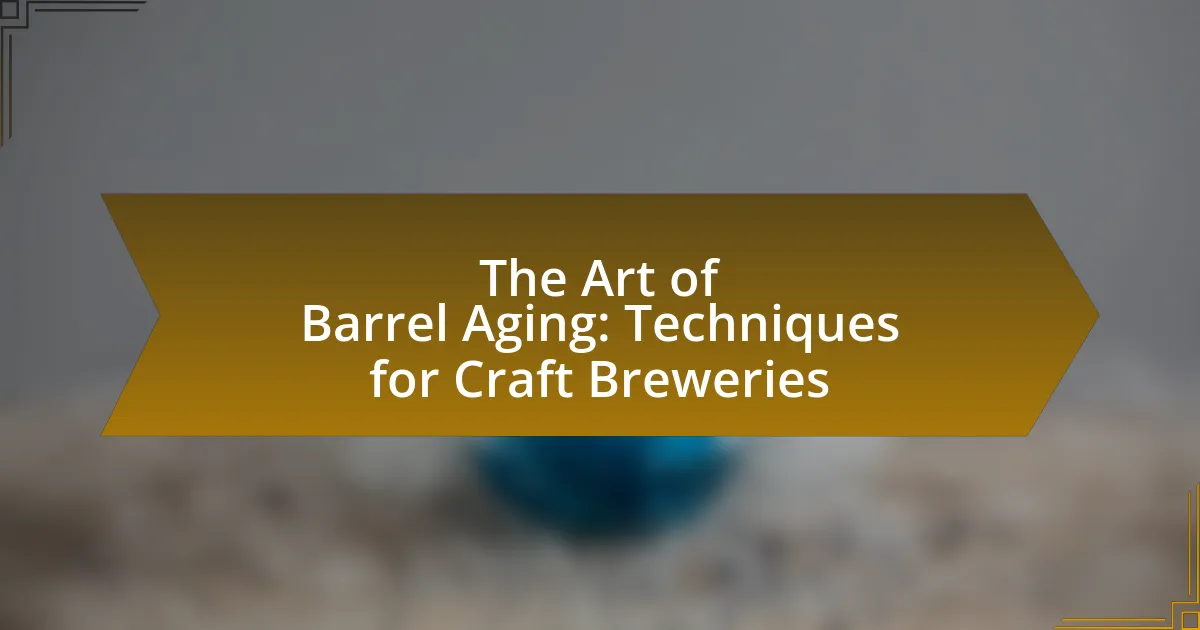The article focuses on techniques for achieving clarity in craft beer, highlighting key methods such as proper filtration, cold crashing, and the use of fining agents. It examines how the brewing process, including mashing, boiling, and fermentation, influences beer clarity, and discusses the impact of different yeast strains and malt types on haze formation. Additionally, the article addresses the significance of water chemistry, common challenges brewers face in achieving clarity, and troubleshooting steps to enhance the final product’s visual appeal. Best practices for clarity during the brewing process are also outlined, emphasizing the importance of ingredient quality and sanitation.

What are the key techniques for achieving clarity in craft beer?
The key techniques for achieving clarity in craft beer include proper filtration, cold crashing, and the use of fining agents. Filtration removes particulates and yeast, enhancing clarity; cold crashing involves lowering the temperature of the beer to encourage sediment to settle, which can then be removed; and fining agents, such as gelatin or isinglass, bind to haze-forming proteins and precipitate them out of the beer. These methods are widely recognized in brewing practices, with filtration and cold crashing being standard procedures in many breweries to ensure a clear final product.
How does the brewing process influence beer clarity?
The brewing process significantly influences beer clarity through various stages such as mashing, boiling, and fermentation. During mashing, enzymes break down proteins and starches, which can lead to haze if not properly managed. Boiling helps coagulate proteins and precipitate unwanted compounds, enhancing clarity. Additionally, fermentation can introduce yeast and other particulates that may cloud the beer; thus, proper yeast management and conditioning are crucial for achieving a clear final product. Research indicates that the use of fining agents, such as gelatin or isinglass, during fermentation can further improve clarity by binding to haze-forming particles and facilitating their removal.
What role does fermentation play in achieving clarity?
Fermentation plays a crucial role in achieving clarity in craft beer by facilitating the breakdown of yeast and other particulates that can cloud the final product. During fermentation, yeast consumes sugars and produces alcohol and carbon dioxide, while also generating byproducts such as proteins and polyphenols that can contribute to haze. As fermentation progresses, yeast flocculates, or clumps together, allowing for sedimentation. This process helps to remove suspended particles, leading to a clearer beer. Studies have shown that proper fermentation management, including temperature control and yeast strain selection, can significantly enhance the clarity of the final beer.
How do different yeast strains affect beer clarity?
Different yeast strains significantly influence beer clarity by varying their flocculation characteristics and the production of haze-forming compounds. High-flocculating yeast strains, such as certain lager yeasts, tend to clump together and settle more effectively, resulting in clearer beer. In contrast, low-flocculating strains, like some ale yeasts, may leave more suspended particles, leading to hazier beer. Additionally, yeast strains that produce higher levels of proteins and polyphenols can contribute to haze formation, while those that produce fewer of these compounds promote clarity. Studies have shown that the choice of yeast can account for differences in clarity, with specific strains being selected for their ability to enhance the visual appeal of the final product.
What ingredients contribute to clarity in craft beer?
Hops, malt, yeast, and fining agents contribute to clarity in craft beer. Hops can add bitterness and aroma but also influence haze formation. Malt, particularly pale malts, can provide a clearer base, while yeast type and fermentation conditions affect the clarity by determining how much yeast remains in suspension. Fining agents like gelatin, isinglass, or polyclar are specifically used to precipitate proteins and other haze-forming compounds, resulting in a clearer final product. Studies have shown that the use of these fining agents can significantly reduce haze, enhancing the visual appeal of the beer.
How do malt types impact the clarity of beer?
Malt types significantly impact the clarity of beer by influencing the presence of proteins and polyphenols that can cause haze. For instance, pale malts typically produce clearer beer due to lower protein content, while darker malts, such as roasted or caramel malts, can introduce more haze-forming compounds. Research indicates that the use of specific malt varieties can lead to variations in haze stability; for example, a study published in the Journal of the American Society of Brewing Chemists found that beers brewed with pale malts exhibited a lower haze formation compared to those brewed with high-protein malts. Thus, selecting appropriate malt types is crucial for achieving desired clarity in craft beer.
What is the significance of water chemistry in beer clarity?
Water chemistry is significant in beer clarity because it influences the solubility and precipitation of proteins and polyphenols during brewing. The balance of minerals such as calcium, magnesium, and sulfate affects the pH and the interaction of these compounds, which can lead to haze formation. For instance, higher calcium levels can promote protein-polyphenol interactions that enhance clarity, while excessive sulfate can lead to increased haze. Studies have shown that optimal water profiles can reduce haze formation by promoting the coagulation of unwanted particles during the brewing process, thereby improving the final product’s clarity.

What methods can be employed to enhance clarity in craft beer?
To enhance clarity in craft beer, methods such as cold crashing, filtration, and the use of fining agents can be employed. Cold crashing involves lowering the temperature of the beer after fermentation, which encourages yeast and other particulates to settle at the bottom, resulting in a clearer product. Filtration physically removes suspended particles, while fining agents like gelatin or isinglass bind to haze-forming compounds, facilitating their removal. These techniques are widely recognized in brewing practices for improving the visual appeal and stability of the final product.
How does filtration improve beer clarity?
Filtration improves beer clarity by removing suspended particles, yeast, and other impurities that can cause cloudiness. This process typically involves passing the beer through a filter medium, which captures these unwanted materials while allowing the liquid to flow through. Studies have shown that filtration can reduce haze-forming compounds, such as proteins and polyphenols, thereby enhancing the visual appeal of the final product. For instance, a study published in the Journal of the American Society of Brewing Chemists demonstrated that effective filtration techniques significantly decreased turbidity levels in various beer styles, confirming the efficacy of filtration in achieving a clearer beer.
What are the different types of filtration methods used in brewing?
The different types of filtration methods used in brewing include mechanical filtration, membrane filtration, and diatomaceous earth filtration. Mechanical filtration involves using physical barriers, such as mesh screens or filters, to separate solids from liquids, effectively clarifying the beer. Membrane filtration utilizes semi-permeable membranes to remove particles and microorganisms, ensuring a sterile product. Diatomaceous earth filtration employs a porous material made from fossilized algae to trap solids while allowing liquid to pass through, enhancing clarity and stability. Each method contributes to achieving clarity in craft beer by removing unwanted particulates and microorganisms.
What are the pros and cons of using filtration for clarity?
Filtration for clarity in craft beer has distinct pros and cons. The primary advantage is that filtration effectively removes unwanted particles, yeast, and haze-forming proteins, resulting in a clearer product that appeals to consumers. This clarity can enhance the visual appeal and perceived quality of the beer, as studies show that consumers often associate clarity with freshness and quality.
Conversely, the main disadvantage of filtration is that it can strip some flavor compounds and aromas, potentially diminishing the beer’s overall character. Additionally, excessive filtration may lead to a loss of certain beneficial yeast and proteins that contribute to mouthfeel and complexity. Therefore, while filtration can improve clarity, it may also compromise the beer’s flavor profile and uniqueness.
What role does cold crashing play in achieving clarity?
Cold crashing plays a crucial role in achieving clarity in craft beer by promoting the settling of suspended particles and yeast. When beer is rapidly cooled to near freezing temperatures, the reduced kinetic energy allows these particles to aggregate and settle at the bottom of the fermentation vessel. This process significantly decreases the turbidity of the beer, resulting in a clearer final product. Studies have shown that cold crashing can reduce haze-forming proteins and yeast cells, enhancing the visual appeal and overall quality of the beer.
How does temperature affect the settling of particulates?
Temperature significantly affects the settling of particulates by influencing their kinetic energy and the viscosity of the liquid medium. As temperature increases, the kinetic energy of the particulates rises, leading to faster movement and potentially slower settling due to increased turbulence. Conversely, lower temperatures result in higher viscosity, which can enhance the settling rate of particulates by reducing their mobility. Studies have shown that at optimal temperatures, such as those used in fermentation and conditioning processes in craft beer production, particulates can settle more effectively, improving clarity.
What is the ideal duration for cold crashing to maximize clarity?
The ideal duration for cold crashing to maximize clarity is typically 24 to 48 hours. This timeframe allows yeast and other particulates to settle effectively, resulting in a clearer final product. Research indicates that cold crashing at temperatures around 32°F (0°C) enhances the sedimentation process, leading to improved clarity in craft beer.

What are common challenges in achieving clarity in craft beer?
Common challenges in achieving clarity in craft beer include the presence of suspended particles, yeast haze, and protein-polyphenol interactions. Suspended particles, such as yeast and hop residues, can cloud the beer, making it visually unappealing. Yeast haze occurs when yeast remains in suspension after fermentation, particularly in unfiltered beers. Additionally, protein-polyphenol interactions can lead to chill haze, which becomes apparent when the beer is chilled. These factors complicate the brewing process and require techniques like filtration, fining agents, and proper fermentation management to enhance clarity.
What factors can lead to haziness in craft beer?
Haziness in craft beer can result from several factors, including the presence of suspended yeast, proteins, and hop particles. During fermentation, yeast can remain in suspension, contributing to a cloudy appearance. Additionally, proteins from malt and adjuncts can interact with polyphenols from hops, forming haze. Furthermore, insufficient filtration or cold crashing can leave residual particles in the beer. These elements collectively affect the clarity of the final product, making it appear hazy rather than clear.
How do protein-polyphenol interactions cause haze?
Protein-polyphenol interactions cause haze in craft beer by forming insoluble complexes that aggregate and scatter light. When proteins, which are abundant in beer, interact with polyphenols, typically derived from malt and hops, they create these complexes. The resulting aggregates can increase the turbidity of the beer, leading to a hazy appearance. Studies have shown that specific types of proteins, such as those from barley, are particularly prone to forming these haze-inducing complexes with polyphenols, especially under certain pH and temperature conditions. This phenomenon is well-documented in brewing science, highlighting the importance of managing protein and polyphenol levels to achieve clarity in the final product.
What impact does over-hopping have on beer clarity?
Over-hopping negatively impacts beer clarity by introducing excessive hop particles and oils that can lead to haze formation. When hops are added in large quantities, particularly late in the brewing process, they contribute to the presence of polyphenols and proteins that can interact and create turbidity. Research indicates that high levels of hop additions can increase the likelihood of chill haze, which is a common clarity issue in beer, especially when it is cooled. Therefore, managing hop quantities is essential for maintaining optimal clarity in craft beer.
What troubleshooting steps can brewers take to improve clarity?
Brewers can improve clarity by implementing several troubleshooting steps, including proper filtration, adjusting pH levels, and ensuring adequate fermentation time. Filtration removes suspended particles that contribute to haze, while maintaining a pH between 4.0 and 4.5 can enhance protein stability, reducing cloudiness. Additionally, allowing sufficient fermentation time enables yeast to settle and clarify the beer naturally. These methods are supported by brewing science, which indicates that effective filtration and optimal pH levels significantly contribute to the clarity of the final product.
How can brewers adjust their recipes to enhance clarity?
Brewers can enhance clarity in their beer recipes by incorporating fining agents such as gelatin, isinglass, or polyclar. These agents help to precipitate and remove suspended particles, resulting in a clearer final product. For example, gelatin is a widely used fining agent that binds to proteins and yeast, facilitating their removal during the fermentation process. Additionally, brewers can adjust the mash temperature and pH levels to optimize enzyme activity, which aids in breaking down haze-forming compounds. Studies have shown that controlling these variables can significantly improve beer clarity, as evidenced by research published in the Journal of the American Society of Brewing Chemists, which highlights the effectiveness of fining agents in reducing turbidity.
What best practices should be followed during the brewing process for clarity?
To achieve clarity in craft beer during the brewing process, it is essential to implement several best practices. First, proper sanitation of all equipment prevents contamination that can lead to haze formation. Second, using high-quality ingredients, particularly malt and hops, minimizes the introduction of unwanted proteins and polyphenols that contribute to cloudiness. Third, employing a cold crash technique after fermentation allows suspended particles to settle, enhancing clarity. Fourth, fining agents such as gelatin or isinglass can be added to help precipitate haze-forming compounds. Lastly, filtration can be utilized as a final step to remove any remaining particulates, ensuring a clear product. These practices are supported by brewing science, which indicates that clarity is significantly influenced by the management of proteins and yeast during the brewing process.






